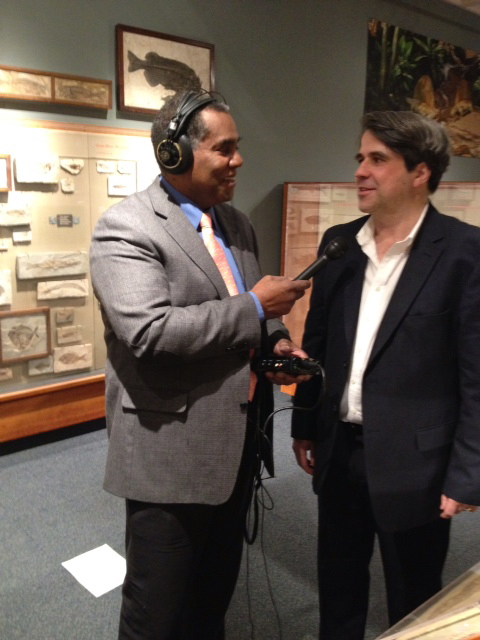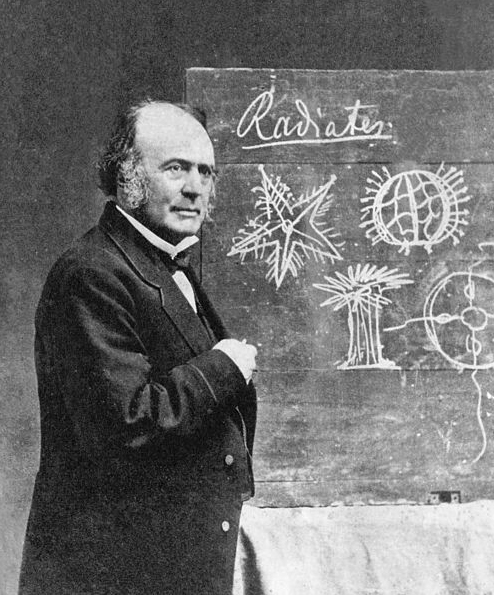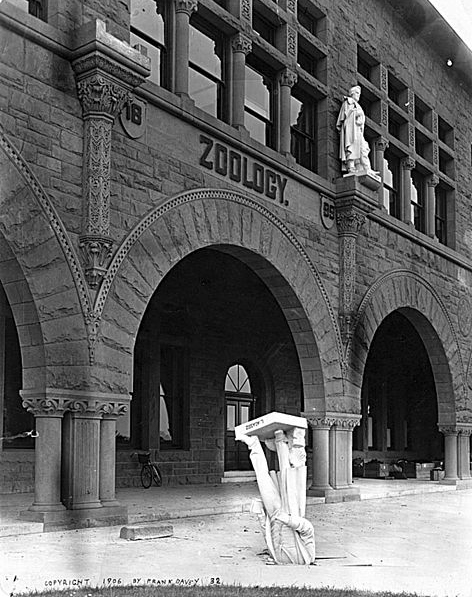Louis Agassiz
Air Date: Week of February 15, 2013

Christoph Irmscher, is author of the new book, Louis Agassiz: Creator of American Science. He’s a professor of English at Indiana University in Bloomington, Indiana. (Photo: Annie Sneed)
The legendary naturalist Louis Agassiz was much loved by Americans in his time, but today, Agassiz has a mixed legacy. Host Steve Curwood talks with author and Indiana University English professor Christoph Irmscher about his new biography, “Louis Agassiz: Creator of American Science.”
Transcript
CURWOOD: Harvard University’s Museum of Natural History was founded by the great 19th century naturalist, Louis Agassiz. Passionate and popular at the time, today Agassiz has a mixed legacy; he was both an enthusiastic racist and a denier of Darwin’s theory of evolution. Professor Christoph Irmscher of Indiana University at Bloomington is author of a new biography called “Louis Agassiz: Creator of American Science.” As we spoke during a visit to the Museum Agassiz founded, he said the man was hard to classify.
IRMSCHER: Louis Agassiz was a Swiss naturalist, he was a paleontologist, he was a zoologist, he was a marine biologist, he was an embryologist. There was no limit to his interests, and he brought the comprehensiveness of his interests to the United States, trying to instill the love of science in the masses.
CURWOOD: So let’s get Louis Agassiz from Switzerland to the United States, starting with his upbringing. How did his upbringing spur his passion for science?
IRMSCHER: He was born in Môtier, a small village close to a lake. He was an avid sportsman, avid outdoorsman, avid collector. His father was a country parson who did not encourage his plans to become a scientist, and that's what he really wanted to be, and he didn't want to become a doctor, that was his father’s career plan. He compromised by getting a degree in medicine, but getting a degree in natural history at the same time. And he studied with the great Cuvier, the greatest biologist of his time, as he saw it, and he acquired the mentorship of Alexander Van Humboldt who is probably the second great man. He had enormous nurturing. Coming to America in 1846 is the best career move that could have happened. What also happened is that his marriage failed. His first wife - who was not equipped to put up with somebody whose main interest wa science and hanging out with his buddies in the mountains and trekking on glaciers - she did something unprecedented - she took the kids, left him, moved out, at that point the invitation came to come to Boston.
CURWOOD: Louis Agassiz was famous for his work on glaciation. This was big time for Agassiz and his glacier work. He’s really among the very first to say we had ice ages.
IRMSCHER: He was the first to promote the notion of the ice age publicly, but there were people who had been working on it. There were scientists in Switzerland who had been talking about this for some time. There were even guides, mountain guides who had discovered things they would share with Agassiz. Agassiz was always very adept at taking an idea that other people had been thinking about and making it into his, and promoting it as such, and it happened in his career again and again. He had a falling out with somebody who basically said, “I did this and you’re taking my work.” In this case, it was a fellow student that he met in Munich who had been working on similar things, and who unfortunately would scribble his notions, his ideas, on loose sheets of paper, but not take them to the public. Agassiz did.
CURWOOD: So how did Agassiz the great naturalist first become recognized for his scientific prowess?
IRMSCHER: He first became recognized essentially for his work on Brazilian fish. He, when he was a student in Munich, he was promoted by one of his professors who was working on a volume about Brazilian fish, and Agassiz was the one who completed it, and that was essentially what put him on the map. He was very proud and he wrote to his sister at the time, ‘would it not be a great thing if the best book in our father’s library is a book written by me?’ And then he embarked on many multi-volume projects, one of which was about fossil fish. That was really what got the most attention and what kept encouraging him - work on the fish, complete your fish.

The museum complex, which includes both the Harvard Museum of Natural History and the Museum of Comparative Zoology, founded by Agassiz. This building was not built until 1892, long after his death. (Photo courtesy of Harvard Museum of Natural History).
CURWOOD: We’re in the Museum of Natural History here at Harvard that Louis Agassiz founded, and we’re in the room that has all these fossil fish. What of this collection do you think he knew something about directly?
IRMSCHER: This is actually a fossil fish specimen that he collected that was what his multi-volume work on fossil fish was about. Looking at the past, trying to find traces of life in fossil specimens. On his lecture circuit one of the things that he perfected that was one of his party tricks, he’d ask audiences to give him a scale of any fish and he would, from that single scale, draw in chalk the fish on the blackboard with both hands because he was ambidextrous and so the fish would emerge. He would ask the audiences to weigh in on what else was missing. The fins, the head and finally a living fossil fish. An oxymoron would rise before his audiences.
CURWOOD: Louis Agassiz was very prominent in his time, obviously, but he was also one of the fiercest critics of Charles Darwin, and Darwin's theory of evolution. Why did Louis Agassiz so adamantly object to the notion of evolution?
IRMSCHER: He believed that God's hand was visible in creation, that everything that had been created was supposed to be, or had been ordained to be by God. So there was this divine purpose in nature. He felt - and this is where things get perhaps a tad provocative - he also felt that the scientist was capable of deciphering God’s plan to the extent that there really were no secrets in nature for Agassiz. Secrets are there just because you have not uncovered them yet, but it was not a hypothesis that made any sense to Darwin.
He didn’t need a divine principle to describe nature. He described nature as unfolding on his own terms without any human presence required. There’s no human observer required. For Darwin, as he later said in “The Descent of Man”, there’s no more amazing instrument than the brain of the ant. That is not something that Agassiz accepted as a working premise, human superiority was what underlies all of Agassiz’s thinking, all of his work. It's very close to Emerson in nature - Emerson says at one point that the ant is interesting precisely for the ray of relation that goes from the ant to me.
CURWOOD: So what was the nature of the personal relationship between Charles Darwin and Louis Agassiz?

Living on Earth Host Steve Curwood talking with author Christoph Irmscher. (Photo: Annie Sneed)
IRMSCHER: It was a relationship that started with Darwin respecting Agassiz for his knowledge of data. Field work was Agassiz’s specialty. Darwin always relied on observers in the field that would provide him with things that he needed. It started with Agassiz essentially encouraging him to work on barnacles which Darwin did, and it was work that was very important for Darwin en route to the “Origin of Species”. Agassiz would provide him specimens, and the more Darwin realized what he was working on, where he was headed, the clearer it became to him that Agassiz would be his main target. And very, very fortunately for him, Agassiz’s colleague at Harvard, Asa Gray, a brilliant botanist, became Darwins’s respondent, became his associate essentially in promoting the theory and Asa Grey became quite brilliant in provoking Agassiz into making public statements, into embarrassing himself publicly in service of Darwin’s theory. Darwin would continue to write to Agassiz for information that Agassiz would still try to answer. Darwin sent him a complimentary copy of the “Origin of Species” offering it as he said to Agassiz “in the best spirit of scientific inquiry”. And the heavily marked up copy is still here at Harvard - Agassiz’s copy of Darwin’s “Origin of Species”.
CURWOOD: He didn’t tear out any pages?
IRMSCHER: He did not.
CURWOOD: So Louis Agassiz’s first wife walks out on him - he’s insufferable, and he comes to the United States, and he gets married, and not just to an ordinary woman, but to one of the first families in Boston - Elizabeth Cabot Cary - I believe was her name. How did that work out?

Louis Agassiz in 1870. (Photo: Wikipedia)
IRMSCHER: It worked out extremely well for him. He married a woman who was very gifted - she was a talented writer - and she became his public voice basically. She became the woman who wrote down his lectures, published them as articles. She became later on the founder of Radcliffe College, which some people see as a direct outgrowth of the kind of training she had received under Agassiz. She was in the field. She would always distance herself a little bit from what was going on and would say, “I’m just an amateur.” But in order to write the things she did, she had to be much more than an amateur.
CURWOOD: So Louis Agassiz may not have been such a big deal without this woman in his life.
IRMSCHER: He was a big deal when he came. He would have had a hard time maintaining his big deal reputation without her.
CURWOOD: Here in Cambridge, Massachusetts, where we are at the Museum of Natural History at Harvard, he’s rather famous for his racism. Why was Louis Agassiz such an outspoken racist? Why did he care?

(Photo: Houghton Mifflin Harcourt)
IRMSCHER: It’s a complex story. Race played no real part in his scientific work before he came to the United States. When he came to the United States in 1846, he realized quickly that having an opinion on race, being an expert on race, would further bolster his public importance. He believed in biological differences between races as if they were species. He believed there were biological differences that made it impossible for blacks and whites to intermarry. And he would publicly talk about these biological issues. All of it sounds very offputting - one thing that we need to remember is that most of his racial opinions were shared by people at the time. None of this was important for the rest of his scientific work. It is a puzzling fact that he got so engaged in it. Do I wish he had not said any of this? Yes, but in part the book got its impetus from the complexity of this man with many, many affable, many, many positive sides - and other sides that are deeply troubling - and they’re part of the same coin.
CURWOOD: Indeed Louis Agassiz had many, many faults - selfish, plagiarizing, racist, braggart - yet he was admired by many people in America who looked up to him. Why do you think?

During the 1906 San Francisco earthquake, a statue of Agassiz fell from its niche on the front of the Stanford University zoology building. Stanford President David Starr Jordan later wrote, "Somebody – Dr. Angell, perhaps – remarked that 'Agassiz was great in the abstract but not in the concrete." (Photo: Wikipedia)
IRMSCHER: The sheer energy, the sheer passion, that he brought to his work, it was deeply admirable. Here was a man who would show up in the lecture halls, his pocket stuffed with specimens he would pull out. And he would hold something up, he would speak with this absolutely attractive French accent. He would talk about “leedle fish, leedle beetles” he would pull these things out and show them as he was demonstrating. He was a man who would take his students to the beach, and would ask them to go bodily into the water; “If you can’t get the jellyfish out of the water, you need to go where they are.” He would encourage his students to touch things. This was fieldwork in the modern sense. This is what he brought to America, he changed the face of science education permanently. That's part of his legacy. So that's all part of Louis Agassiz as he was at the time. And it’s part of the mesmerizing force that he exerted on the people around him. There’s a famous story that they like to tell that at one point when his eyes had given out from too much looking, and looking was extremely important to him, he used his tongue to taste a fossil specimen, to actually lick it because he wanted that sensory contact with the specimen in front of him, and that was very different from the kind of science people were used to. He believed that science had to be woven into the common life of society, at which he thought that everyone should be knowledgable about science. Everyone theoretically could become a scientist given the proper instruction, which of course someone like Louis Agassiz could provide.
CURWOOD: Christoph Irmscher’s book is called “Louis Agassiz: Creator of American Science.” Thank you so much.
IRMSCHER: Thanks for having me.
Links
The Harvard Museum of Natural History
Living on Earth wants to hear from you!
Living on Earth
62 Calef Highway, Suite 212
Lee, NH 03861
Telephone: 617-287-4121
E-mail: comments@loe.org
Newsletter [Click here]
Donate to Living on Earth!
Living on Earth is an independent media program and relies entirely on contributions from listeners and institutions supporting public service. Please donate now to preserve an independent environmental voice.
NewsletterLiving on Earth offers a weekly delivery of the show's rundown to your mailbox. Sign up for our newsletter today!
 Sailors For The Sea: Be the change you want to sea.
Sailors For The Sea: Be the change you want to sea.
 The Grantham Foundation for the Protection of the Environment: Committed to protecting and improving the health of the global environment.
The Grantham Foundation for the Protection of the Environment: Committed to protecting and improving the health of the global environment.
 Contribute to Living on Earth and receive, as our gift to you, an archival print of one of Mark Seth Lender's extraordinary wildlife photographs. Follow the link to see Mark's current collection of photographs.
Contribute to Living on Earth and receive, as our gift to you, an archival print of one of Mark Seth Lender's extraordinary wildlife photographs. Follow the link to see Mark's current collection of photographs.
 Buy a signed copy of Mark Seth Lender's book Smeagull the Seagull & support Living on Earth
Buy a signed copy of Mark Seth Lender's book Smeagull the Seagull & support Living on Earth

